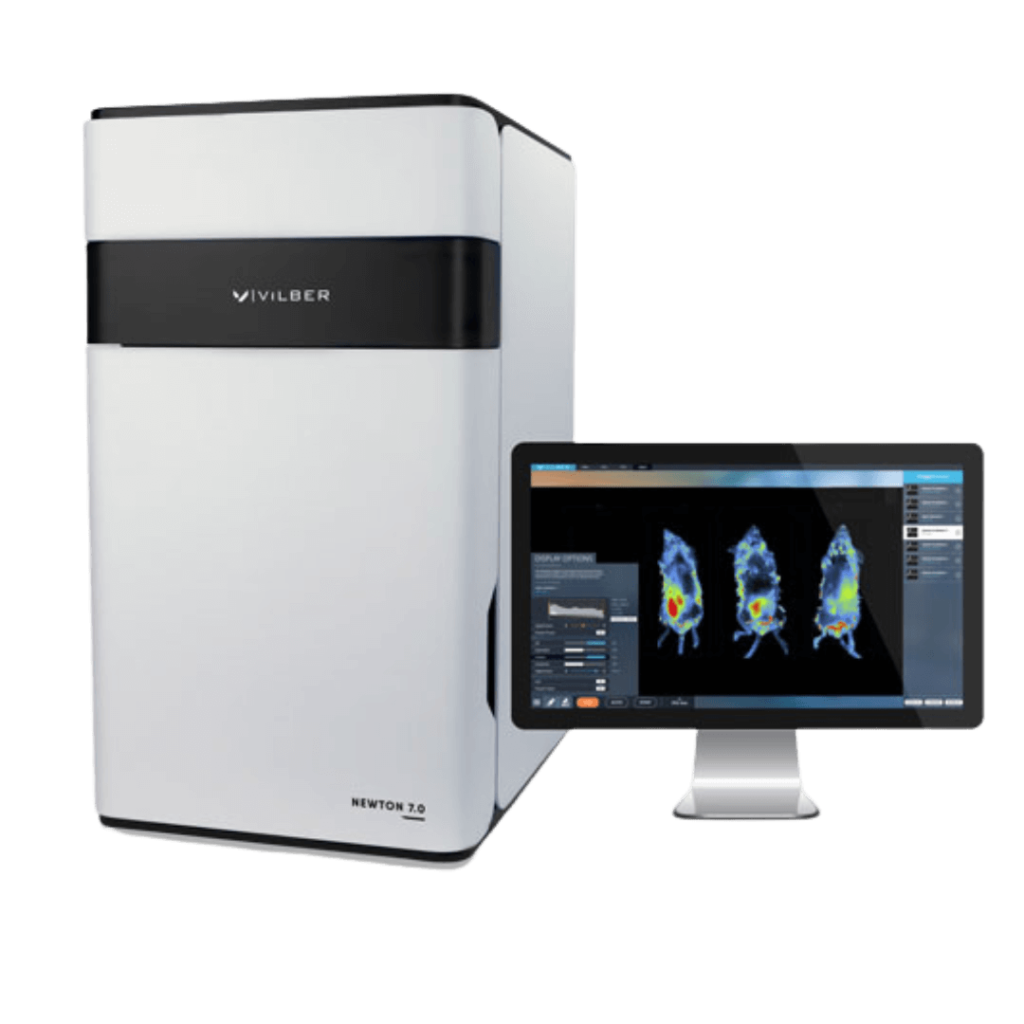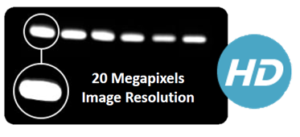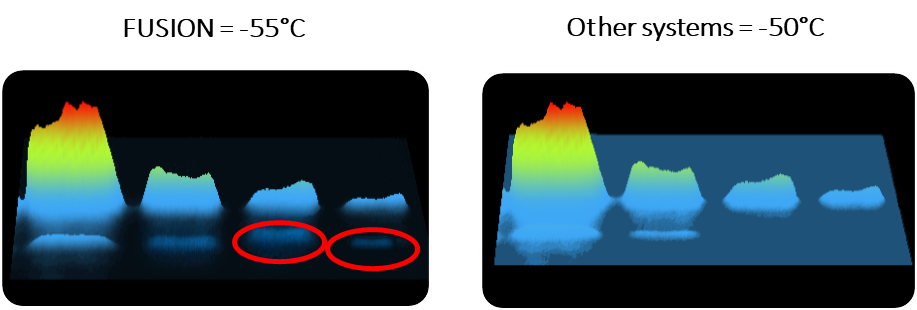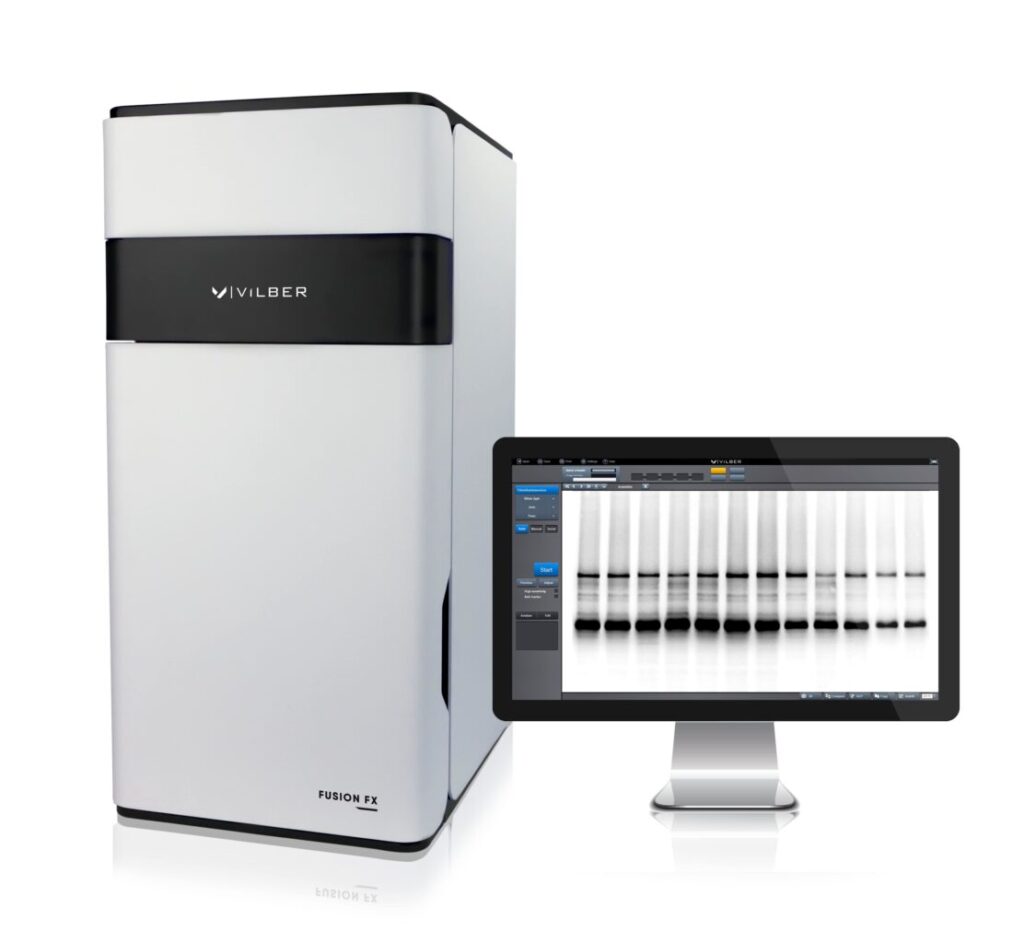System Used:
Newton 7.0

Whether detecting DNA, RNA, or proteins, it is challenging to find many biological publications today not using some form of gel and/or western blot documentation in their findings. While the imaging of high amounts of nucleic acids or proteins should not ever be a challenge for a documentation system, researchers more often find themselves needing to resolve small amounts of these end products. For these researchers and these types of experiments, high-end optics with intelligent analysis software will make a difference in resolving all signals, from the bold and bright to the small and faint. Missing bands could potentially mean missing key data points which can greatly augment vital findings of an experiment. Regardless of budgetary restraints, researchers should have the capabilities to resolve all bands in each and every experiment they perform.
This article will discuss how Vilber gel and western blot documentation technologies have been designed to provide the most advanced optics and analysis for every level of funding. The first part of this article will focus on the optics one can expect to see within Vilber Gel Documentation systems. Next, we will delve into the optics and features that differentiate Vilber Fusion systems from others for performing western blot analysis (including chemiluminescence and multiplex fluorescence applications). Lastly, we will run through some key features outside of imaging that make the Vilber systems stand out in a crowded field of nucleic acid or protein documentation systems.
At the end of this article, you will come away with an understanding of how Vilber has differentiated itself from other systems based on its outstanding optics, revolutionary software, and an array of technological advancements.
Vilber Gel Documentation Systems
16-bit Scientific Camera
Vilber assembles their optics and camera components in-house, meaning they have been precisely and specifically designed for the sole purpose of imaging gels within their systems. So, what makes these cameras different than what you may see in other comparable systems? For starters, the cameras used in all Vilber imaging systems are true 16-bit cameras. This means the systems can detect up to 65,536 grey levels instead of the industry-standard 12-bit cameras that only perceive 4,096 grey levels. That represents a 16X increase in the native grey levels and naturally increases the ability to pick up small levels of nucleic acids and resolve close bands.
Importantly, 65,536 grey levels provide more information for the Vilber software to work with. This notably helps determine the outer limits of all bands, thus increasing confidence in quantitative data analysis.
Lastly, for data export purposes, it is also pertinent to keep in mind that the Vilber systems generate a native 16-bit tiff image. This is drastically different from what is seen when using 12-bit cameras, as additional software is always needed to post-process and convert those images into 16-bit resolution (publication standard). This is not particularly relevant as these algorithms add grey levels that may or may not be there. All in all, a 16-bit camera provides researchers the confidence in knowing they are obtaining the most precise and accurate results possible.
Image Resolution
The proprietary optics of Vilber Gel Documentation systems also deliver the highest resolution in the industry. Whereas most systems offer an upper resolution of 1 to 5 megapixels, the Vilber systems standard configuration has an upper resolution of 20 megapixels. What this means for researchers is all bands will be as sharp and crystal clear as possible, allowing for close bands to be distinguished and for all information to be as quantitatively accurate as possible. Higher resolution further allows better performance in pattern recognition within the software.

Super-Bright UV Transilluminator
For those needing to use UV transillumination, Vilber has engineered pad technology in the form of the Super-Bright transilluminator. This illuminator has a unique filter coating which makes UV tubes appear invisible. This means that users will not say any background light and will have enhanced signal images leading to better results than using a standard UV transilluminator. It is evident in the image below how much easier it is to distinguish bands from one another and view faint bands on the Super-Bright UV background.

As a side point, blue and white light pads are also available for researchers needing other light sources for their gel applications. For those with multiple gel imaging applications, conversion screens are also available to change UV into white or blue light.
Vilber Fusion Chemiluminescence and Fluorescence Systems
Deepest Cooled Camera
The Fusion, like all major imaging systems that document western blots, uses a 16-bit CCD camera. While the Vilber Fusion cameras continue to offer leading optics in resolution, more importantly, they also lead the industry in the cooling provided to the CCD cameras themselves. Why is this important? Cameras generate heat, and heat generates noise in images, which can affect the ability to detect the faintest of signals. In order to better distinguish signals from noise, the Fusion’s premier camera is cooled to -90°C to ensure the best signal to noise ratio. Even for those researchers needing a more budget-friendly option, the Fusion can be equipped with a -55°C camera which still tops the industry-standard -50°C.
As you can see below, even a 5°C change is enough to help the Fusion system resolve extremely faint bands.

Widest Lens in the Industry
The primary function of a camera lens is to collect light and the lens aperture represents its capability to collect as much light as possible in a given period. The sensitivity is usually expressed by a range of f-stops. A lower f-number denotes a greater aperture opening, which allows more light to reach the CCD sensor. The Fusion lens’s aperture is f/0.70, providing the best sensitivity and speed to reach the lowest limits of detection compared to systems with smaller aperture openings.

Broadest Dynamic Range Possible
In a general sense, dynamic range describes the ratio between the maximum and minimum measurable light intensities. When we refer to imaging of western blots, we refer to how weak signals can be captured without saturating bold bright ones. The Vilber Fusion system’s optical density range of 4.8 is industry-leading and means researchers can get optimal images of high and low abundance proteins together.
What Else Sets Vilber Apart?
Intuitive Software is Always Free
For image editing and analysis, the license-free software offers plenty of enhanced features to easily and quickly produce publication-ready images.
The image analysis package consists of a quantification module, a molecular weight module, a distance (Rf) calculation module and even a colony counting module. The system has a simple 1-click export to excel or PDF format, making it simple to move and save data to whatever platform is needed.
High Quality and Robust Systems
Building products with high-quality components ensures that systems are long-lived and can handle frequent day to day usage. While most systems are primarily constructed of plastic, Vilber has designed its system from stainless steel andaluminum to ensure they can handle the daily wear and tear placed upon them. Even the touch screen models have been designed with magnesium reinforced protective glass to ensure the screen can handle impacts should this accidentally happen.
Customized to Meet Needs and Budgets
Researchers have different needs and desires when it comes to imaging their nucleic acids and proteins. Vilber fully understands this and has designed several systems that will provide the best performance at every level of funding or class of system required. Systems can be easily customized and upgraded over time to meet changing needs.
Over 20,000 labs worldwide trust Vilber as a leader in the molecular imaging sector. To learn more about the documentation systems that Vilber offers, please visit our Vilber webpage or contact one of our applications specialists by email at sales@scintica.com, or by phone at 832-548-0895
